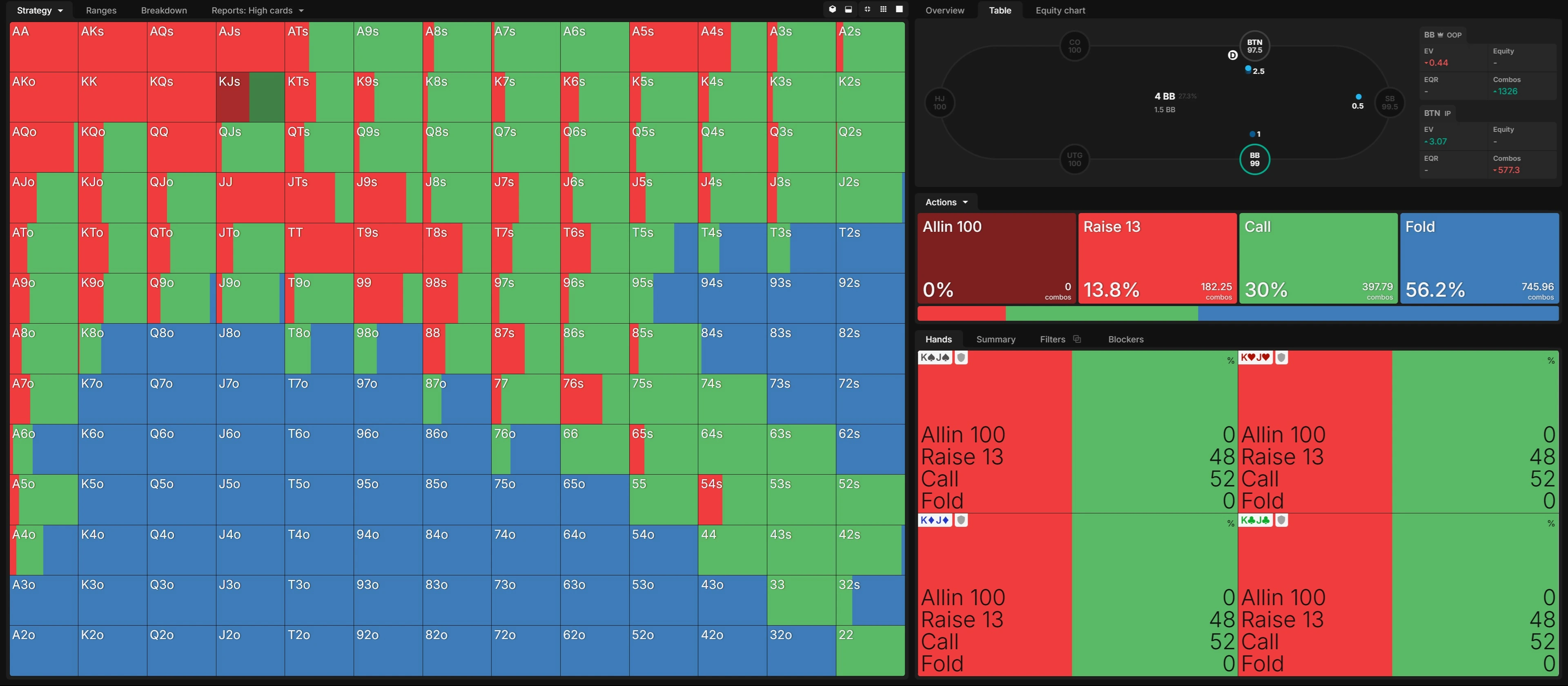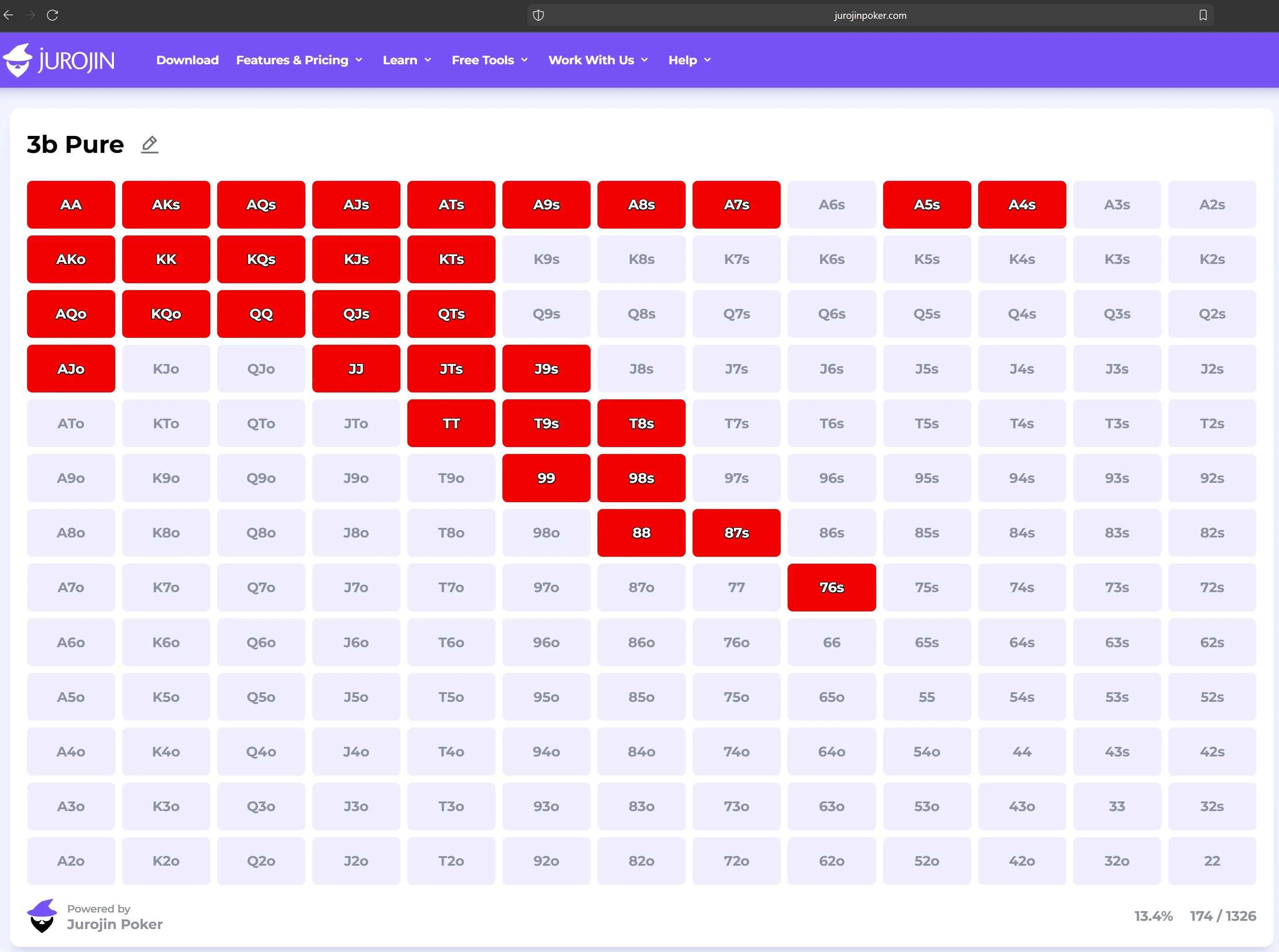Poker Betting Strategies: 3-Bet & 4-Bet

Apr 16, 2025
•
2 min read
So against the more liberal three-better, maybe you're going to throw in another four-bet and push him back around. And against the tighter player, maybe you let him get away with it because you know he's not three-betting enough.
- Daniel Negreanu
We last discussed preflop strategy with an overview of GTO charts, how they’re created, and when we can deviate from them to better exploit fish or any player with a suboptimal strategy.
This section continues our exploration of preflop strategy as we put a magnifying glass on preflop poker betting. Specifically, we’ll cover re-raises, also referred to as 3-bets and 4-bets.
If you’re ready to learn how this applies to preflop 3bet and 4bet ranges, let’s move ahead!
Bet in Poker Rules
Quite simply, a 1-bet, 2-bet, 3-bet, 4-bet and so forth refer to the order of increasing wagers going into the pot. Preflop, the 1-bet refers to the big blind. Although it’s forced, it’s still the 1st bet. Therefore, any open raise becomes the 2-bet.
For example, say the preflop action folds to the button and that player open raises to 2.5bb: that raise is the 2-bet.
In this scenario, when the small blind raises the button to 11bb, it’s called a 3-bet since it’s the third increase in preflop wagers. If the big blind raises again, say to 25bb, that becomes a 4-bet.
Alternatively, if the big blind folds and the action returns to the button, the button can fold, call, or re-raise. If the button re-raises the small blind’s 11bb 3-bet to, for example, 23bb, that would also be considered a 4-bet.
With this terminology clarified, let’s dive into theory and actionable tips.
Poker Betting Strategies
We’ve discussed that the primary reasons to place bets are value and bluffing. This implies that preflop, like in all cases, it’s the value portion of our range that allows up to bump up the price of seeing a showdown.
In simplest terms, we’re saying that for bluffs to work, we must be able to credibly represent a strong hand. Preflop, this boils down to a simple rule: avoid re-raising after calling.
Betting effectively in poker is critical to avoid capping your range, essentially signaling that you lack strong hands.
For example, imagine a fish open-limps and we just call from the small blind. The big blind then raises to 7bb, the fish calls, and we 3-bet to 21bb.
Does it seem like we’re holding a premium hand? Definitely not. If we had strong hands like pocket aces or kings, we’d likely have raised initially. The big blind will pick up on this and assume they’re ahead—putting us in a weak spot.
Now that this key concept is clear, let’s dive into the strategy you’ve been waiting for.
When to 3-Bet in Poker
Value in poker refers to hands that are way ahead of an opponent’s opening (RFI) range. Position is crucial, as early position (UTG) ranges are tighter to account for more players yet to act. Consequently, 3-betting ranges against UTG are also tighter compared to those against BTN.
Always be ready to adjust your 3-betting strategy based on your opponent's tendencies.
- Doug Polk
For example, GTO charts for big-blind 3bets against UTG in 6max recommend 3-betting around 5% of the time. Against a button RFI though, BB will 3-bet closer to 14% of the time!
Furthermore, a smart poker betting strategy will use 3-bets to isolate the original opener, especially when they are fishy. This happens when someone raises and another person or persons overcall!
Like we learned, those over-callers capped themselves while building the pot, which adds extra benefit to betting since there’s more money to scoop up!
3-Bet ranges
Just like RFI ranges, you can consult google or use a free GTO wizard account to get precise, unexploitable ranges to begin with. However, you will find that solvers love using mixed strategies which can seem complex to a beginner.

When starting out, we recommend a simpler approach that defaults to pure strategies focused on beating up fish. Use Jurojin’s Range Builder to help! After you have tens of thousands of hands, maybe even over 100k, in which you’ve proven to win, you can retool.

At that point, you’ll be able to process concepts like blockers/removal as well as the bunching effect. For now, relax and keep things simple.
So, what are ways to create simple ranges focused on taking advantage of fish? Well, you can use GTO solves to know how often you should 3-bet when in & out of position against early, middle, and late position opens.
Then simply, pick that many of the best hands to 3-bet. For example, if big-blind 3-bets 5% of the time against UTG, just go with the top 5% of your range.
Keep in mind, fish often do not fold to 3-bets. They’ll continue with a wide range that’ll have a hard time facing post-flop bets. Furthermore, use your HUD to guide you. Some fish rarely raise preflop.
When to Avoid 3-Betting in Poker
There are plenty of fish as well as bad, nitty regs that rarely raise first-in. For example, if after 50 hands on a fish their VPIP/PFR stats are 33/1, you can assume their 2-bets are super nutted. Do not 3-bet them unless you have Aces or Kings.
Other than these frequency reads, stack sizes and flop SPRs will affect 3-betting strategies. You can mess around with GTO charts as you do your own digging. In short, when short-stacked you want fewer re-raises in your poker betting strategy.
That’s because it’s much easier to get stacks in post-flop when there’s less money behind. You’ll want to stick to hands that have a higher likelihood of holding at showdown. Since fish love calling 3-bets, we’re unlikely to bluff fish out preflop and need to hold up post.
With all this in mind, let’s hit our final and perhaps most important point. The mighty 4-bet!
When to 4-Bet in Poker
Just like with 3-betting, the types of 4-betting ranges we’ll encounter depending on position, which influences RFI and 3-bet holdings. Our poker betting strategy adjusts to the ranges we face.
In summary, theory says that configurations that have the widest ranges lend themselves to more 4betting. For example, when small-blind 3-bets against a button RFI, we know wide ranges are in play.
That’s why big-blind can cold 4-bet around 6% and remain theoretically unexploitable. Button can also attack small-blind’s wide 3-bet with more 4-bets. Same can be said for cut-off vs button battles.
Types of 4-Betting Ranges
When constructing 4-betting ranges, adjust based on your opponent.
Against fish, who rarely 3-bet, focus on strong, value-oriented hands since they’re unlikely to exploit you. Against regs, consider the low SPRs in 4-bet pots, where money often goes in quickly, and occasionally trap by flat-calling with premium hands like pocket Aces to protect your 3-bet range.
Blockers play a crucial role in 4-bet strategy. Hands like
Adapting your ranges based on these factors ensures a balanced and effective strategy.
When to Avoid 4-Betting in Poker
As we said, we want to avoid 4-betting too much against fish because their 3-bet ranges tend to be strong. It follows that bad regs who 3-bet little also warrant more caution as well as configurations that naturally have tight 3-bet ranges.
For example, when UTG 2-bets and gets immediately 3-bet by UTG+1, we can assume both players have strong ranges. We should avoid cold 4-betting without some premiums of our own, and if we’re UTG, we also should exercise caution.
Conclusion
Re-raising preflop is a powerful tool used to extract value and bluff. Professional poker betting strategies deploy 3-bets and 4-bets under GTO solves.
These solve account for position, blocker properties, and the bunching effect. GTO charts typically mix 3-betting and 4-betting strategies that often confuse beginner players.
It’s recommended to simplify these strategies by creating ranges that always re-raise or not. We recommend that entry level grinders create their own charts that use GTO frequencies while keeping decisions simple and pure.
By using simple strategies and making in game adjustments based on stack sizes, beginners can get their feet wet while posting positive win-rates.
Thank you for reading, and good luck on the felt!
ZOOM IN
The following links are recommended resources related to this section’s theme. Don’t stay in doubt--dive in! 🔔
- Charts: Learn more about preflop chart uses.
- 3 Bets: Learn about advanced 3 bet poker strategy.
- Position: You may want to check this positional guide.
- Sizing: Discover more about preflop bet-sizes.
- Pot Odds: Learn how to calculate pot odds for online poker.
- Discord Community: Join the coolest poker community, don’t be shy! Use it to ask questions and interact with other poker enthusiasts and professionals.